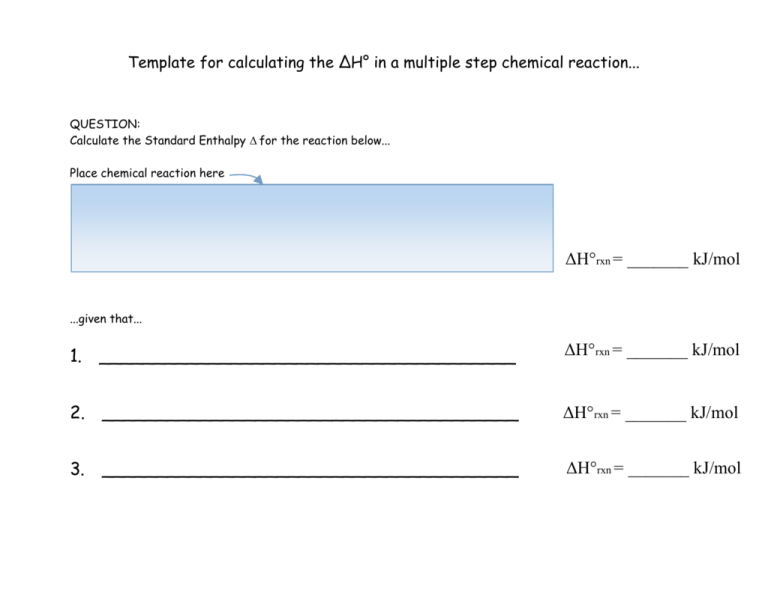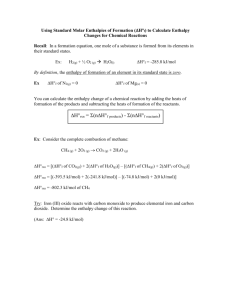ENTHALPY CHANGE FOR MULTIPLE STEP REACTIONS
advertisement

Template for calculating the ΔH° in a multiple step chemical reaction... QUESTION: Calculate the Standard Enthalpy Δ for the reaction below... Place chemical reaction here ΔH°rxn = _______ kJ/mol ...given that... 1. ______________________________________ ΔH°rxn = _______ kJ/mol 2. ______________________________________ ΔH°rxn = _______ kJ/mol 3. ______________________________________ ΔH°rxn = _______ kJ/mol I. Before you begin, make sure all chemical equations are balanced. II. Rewrite the intermediary chemical equations so that they are in the correct order and make sure each reaction is progressing in the same direction as the original equation stated in the question. REWRITE 1. ______________________________________ ΔH°rxn = _______ kJ/mol 2. ______________________________________ ΔH°rxn = _______ kJ/mol 3. ______________________________________ ΔH°rxn = _______ kJ/mol III. Setup the formula for finding the total ΔEnthalpy in the formation of C2H6 (DO NOT FORGET TO ACCOUNT FOR EACH COMPOUND’S COEFFICIENTS) ΔH°rxn (1) + ΔH°rxn (2) ( ( )______ + + ΔH°rxn (3) = )_______ + ( total ΔH° )_______ = _________ kJ/mol PRACTICE PROBLEMS: 1. Calculate the Standard Enthalpy Δ for the reaction... 2 Al(s) + Fe2O2(s) → 2Fe(s) + Al2O3(s) ...given that... 1. 2. 2Al(s) + 3/2O2(g) 2Fe(s) + 3/2O2(g) → → Al2O3(s) Fe2O3(s) ΔH°rxn = -1669.8kJ/mol ΔH°rxn = -822.2 kJ/mol total ΔH° =_________ Write the two steps in the proper order... How to do it... To make Al2O3, you need the O3 from Fe2O3. To do that, you must first carry out the process of breaking up the Fe2O3, which has its own enthalpy of formation. However we are not forming Fe2O3. We are decomposing it. So, we must reverse the equation. Fe2O3 → 2Fe(s) + 3/2 O2 (g) Since the equation is reversed the enthalpy must be changed from -822.2 kJ/mol to 822.2 kJ/mol. 1). Fe2O3 → 2Fe(s) + 3/2 O2 (g) ΔH°rxn = 822.2 kJ/mol Now, we can make Al2O3 from its component parts (Al and O2). 2). 2Al(s) + 3/2O2(g) → Al2O3(s) (the enthalpy of this step remains the same) ΔH°rxn = -1669.8kJ/mol Add the enthalpy of the two steps together to get the total ΔH°rxn 822.2 kJ/mol + (-1669.8 kJ/mol) = -847 kJ/mol 2. Consider the following two reactions... ΔH°rxn = ΔH1 A→2B ΔH°rxn = ΔH2 A→C Determine the enthalpy change for the process... 2B→C The steps are 2B → A → C You can leave the answer like this... -ΔH1 + ΔH2 Additional Practice Problems 3. From the following enthalpy changes, H2 (g) + ½ O2 (g) H2O (l) H = 285.8 kJ N2O5 (g) + H2O (l) 2 HNO3 (l) H = 76.6 kJ 3 ½ N2 (g) + /2 O2 (g) + ½ H2 (g) HNO3 (l) H = 174.1 kJ calculate the value of H for the reaction 2 N2 (g) + 5 O2 (g) 2 N2O5 (g). 28.4 kJ 4. From the following enthalpy changes, CO (g) + SiO2 (s) SiO (g) + CO2 (g) 3 SiO2 (s) + 2 N2O (g) + 8 CO (g) 8 CO2 (g) + Si3N4 (s) calculate the value of H for the reaction 5 CO2 (g) + Si3N4 (s) 3 SiO (g) + 2 N2O (g) + 5 CO (g) H = +520.9 kJ H = 461.1 kJ 2023 kJ . 5. From the following enthalpy changes, H2 (g) + ½ O2 (g) H2O (l) H = 285.8 kJ SO3 (g) + H2O (l) H2SO4 (l) H = 132.5 kJ H2SO4 (l) + Ca (s) CaSO4 (s) + H2 (g) H = 602.5 kJ Ca (s) + ½ O2 (g) CaO (s) H = 634.9 kJ calculate the value of H for the reaction CaO (s) + SO3 (g) CaSO4 (s) -385.9 kJ 6. Describe the difference between Heat Capacity and Specific Heat. an example of each one. Give Heat Capacity is the amount of heat/energy required to raise a substance 1°C. 847 kJ is required to increase 850 g of water from 17°C to 18°C. Specific Heat also is a measurement of how much heat/energy is required to increase a substance’s temperature 1°C, but this is related to 1 gram of that substance. The specific heat of water is 4.184 J/g*°C. So, specific heat is a constant and is identified as an intensive property, whereas Heat capacity is based on the amount of the substance in question, making it an extensive property. 7. Describe the difference between Heat of solution and Heat of dilution. Give an example of each one. Heat of solution is the amount of heat absorbed or released during the act of combining a solute with a solvent. An example is adding salt to water. There are two steps to this process: the Lattice Energy (breking down the molecules) and the heat of hydration (where the ionically charged particles dissolve by attracting to the dipole water molecules. Heat dilution refers to the amount of heat absorbed or released when water is added to a solution already made. In this latter case, if the act of making a solution is exothermic, adding more water will make it even more exothermic (hotter). For example, as you add more and more water to a solution of sulfuric acid and water, the more heat it releases (the more it burns). 8. What is the molarity of a solution that contains 1.724 moles of H2SO4 in 2.50 L of solution? M = 1.724 mol H2SO4 = 0.690 M H2SO4 2.50 L soln 9. What is the molarity of a solution prepared by dissolving 25.0 g of HCl (g) in enough water to make 150.0 mL of solution? M = 25.0 g HCl x 1 mol HCl x 1000 mL soln 150.0 mL soln 36.5 g HCl 1 L soln M = 4.57 M HCl 10. Given the equation: 2Ag2S(s) + 2H2O(l) → 4Ag(s) + 2H2S(g) + O2(g) ΔH = +595.5kJ, calculate ΔH for the following reaction. Ag(s) + ½ H2S(g) + ¼ O2(g) → ½ Ag2S(s) + ½ H2O(l) Answer In this problem, the reaction equation has been reversed and divided by four. The new enthalpy value will be the opposite sign and ¼ its original value: -1/4(+595.5kJ) = -148.9kJ 11. A 1.75 g sample of acetic acid, CH3CO2H, was burned in oxygen in a calorimeter. The calorimeter contained 925 g of water and had a heat capacity of 2.53 kJ/°C. The temperature of the calorimeter and its contents increased from 22.2 °C to 26.5 °C. What is the molar heat of combustion of acetic acid? -945 kJ/mol 12. A 3.5 g sample of quinine, C6H4O2, was burned in a calorimeter with a heat capacity of 3.43 kJ/°C and contained 1.2 kg of water. The temperature of the calorimeter and water increased fromv19.0°C to 28.0°C. a) What is the molar enthalpy of combustion of quinine? ΔH combustion quinine = -76.0 kJ/0.0324 mol = -2350 kJ/mol b) What is the specific enthalpy of combustion of quinine? ΔH combustion quinine = -76.0 kJ/3.5 g = -22 kJ/g 13. The combustion of 1.00 mol of glucose, C6H12O6, releases 2820 kJ of heat. If 2.0 g of glucose is burned in a calorimeter containing 1.0 kg of water, and the temperature increases by 3.5 °C, what is the heat capacity of the calorimeter? 4.8 kJ/°C 14. How many molecules are there in 9.34 grams of water? 3.12 x 10^23 molecules 15. How many grams do 4.30 x 10^21 molecules of UF6 weigh? 2.51 grams 16. IDENTIFY THE REACTIONS The chemical reaction: 2 H2O2 → 2 H2O + O2 is a a. synthesis reaction b. decomposition reaction c. single displacement reaction d. double displacement reaction e. combustion reaction The chemical reaction: Zn + H2SO4 → ZnSO4 + H2 is a a. synthesis reaction b. decomposition reaction c. single displacement reaction d. double displacement reaction e. combustion reaction The chemical reaction: AgNO3 + NaCl → AgCl + NaNO3 is a a. synthesis reaction b. decomposition reaction c. single displacement reaction d. double displacement reaction e. combustion reaction The chemical reaction: C10H8 + 12 O2 → 10 CO2 + 4 H2O is a a. synthesis reaction b. decomposition reaction c. single displacement reaction d. double displacement reaction e. combustion reaction The chemical reaction: 8 Fe + S8 → 8 FeS is a a. synthesis reaction b. decomposition reaction c. single displacement reaction d. double displacement reaction e. combustion reaction REMEMBER THE HONC rule (H = 1 bond; O = 2 bonds; N = 3 bonds; C = 4 bonds)... Keep in mind that besides Hydrogen, the valence shell of every atom must equal 8 (octet rule) 17. These molecules contain one or more double bonds or triple bonds or rings. a. C3H4 b. C2H4O c. C2H4O2 d. CHN N -- C -- H 18. Use the HONC 1234 rule to construct a structural formula for the following: a. C2H7N b. N2H4 c. C2H8N2 19. In your words, explain the Law of Conservation of Energy PPT has a couple of examples 20. ____OPEN___ systems can exchange energy and mass, whereas _CLOSED_ systems allow the transfer of energy (heat) but not mass. 21. What is the third type of system in Thermochemistry? _ISOLATED SYSTEMS__ 22. LIST three examples of an intensive property: MOLARITY, TEMPERATURE, SPECIFIC HEAT 23. LIST three examples of an extensive property: VOLUME, LENGTH, MOLES 24. FROM PPT: The combustion of thiophene, C4H4S(l), a compound used in the manufacture of pharmaceuticals, produces carbon dioxide and sulfur dioxide gases and liquid water. The enthalpy change in the combustion of one mole of C4H4S(l) is -2523kJ. Use this information and data from Table 6.4 (p.247) to establish ΔH°f for C4H4S(l). 81.3 kJ/mol








